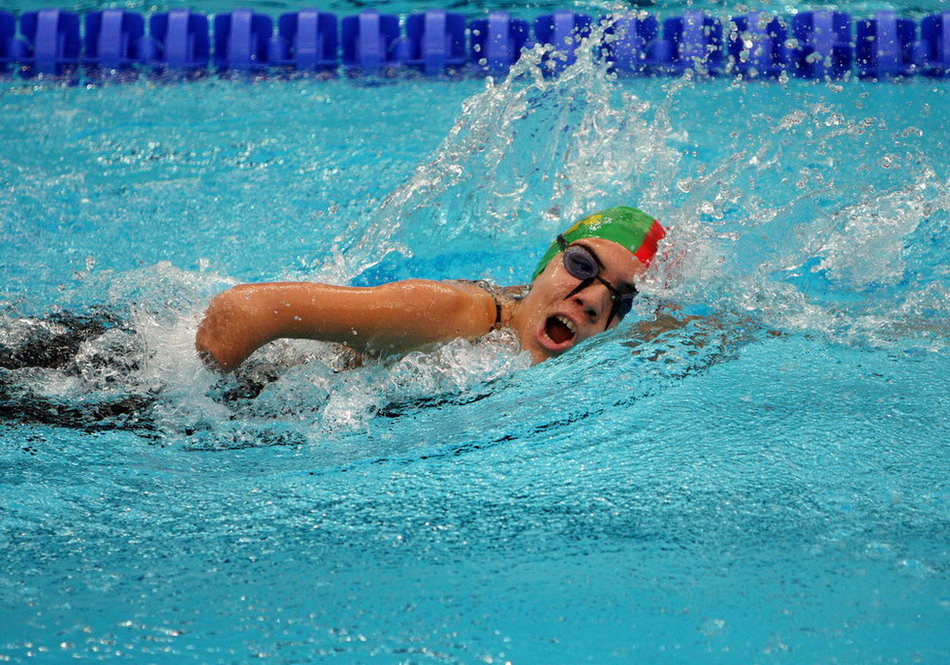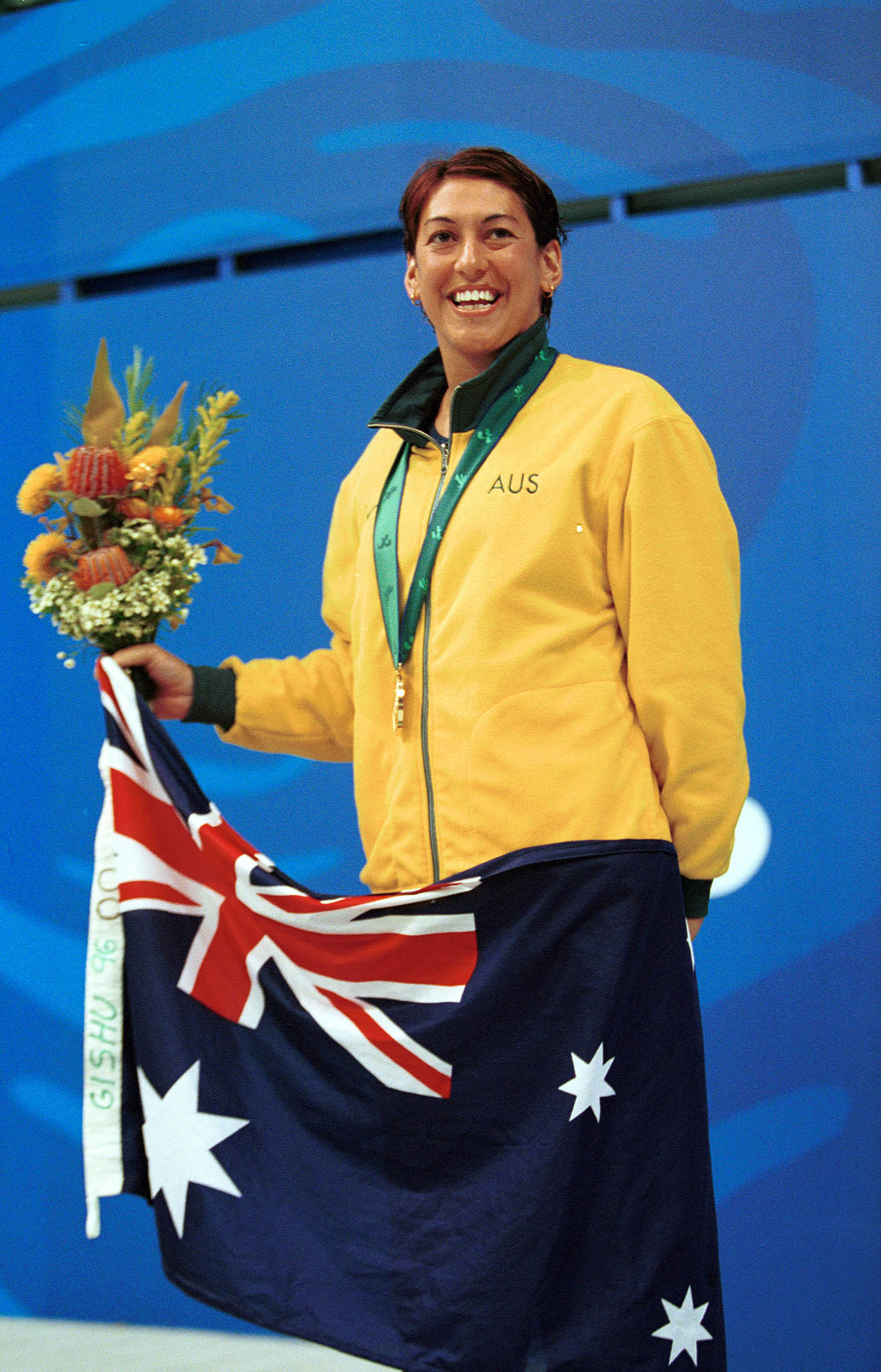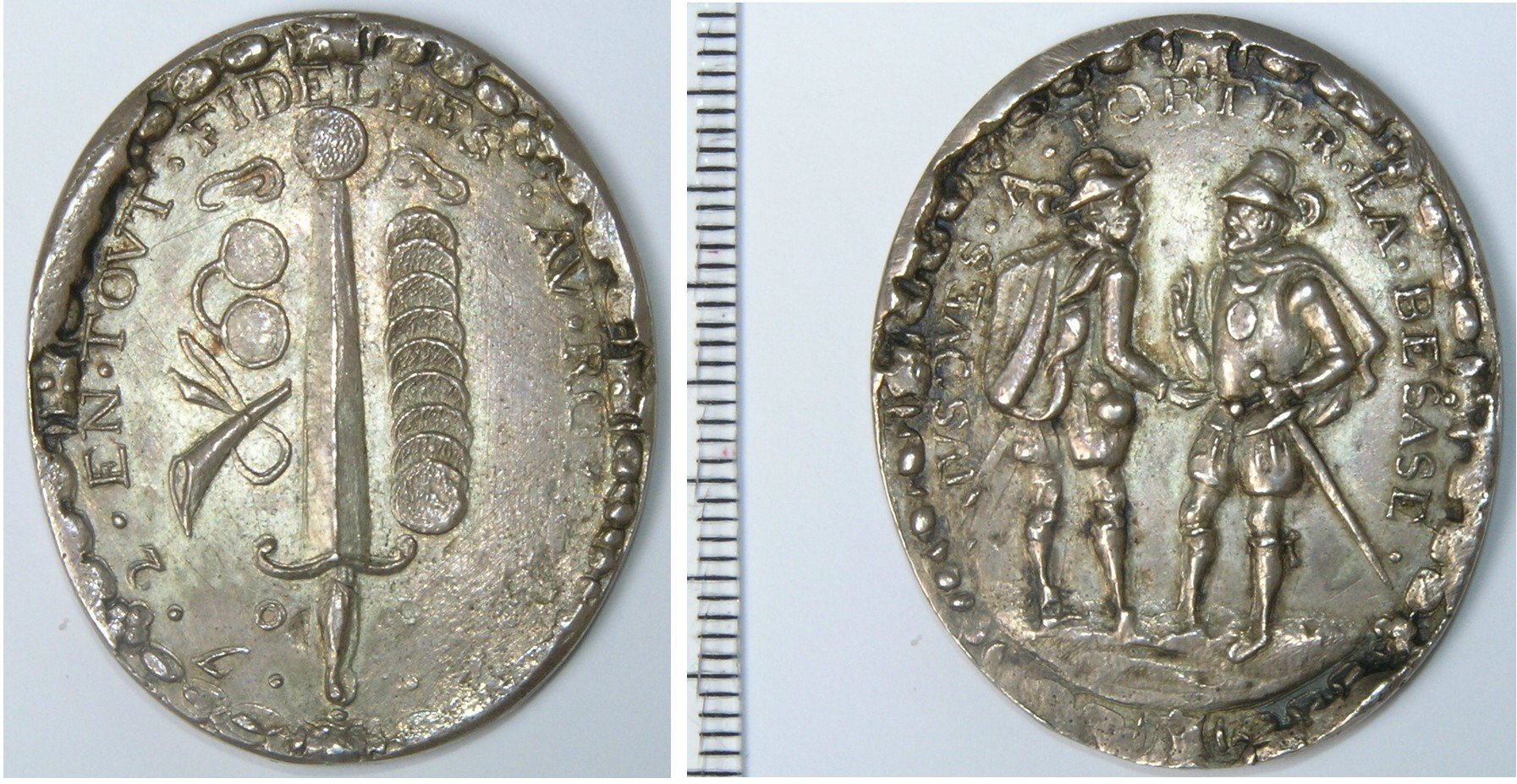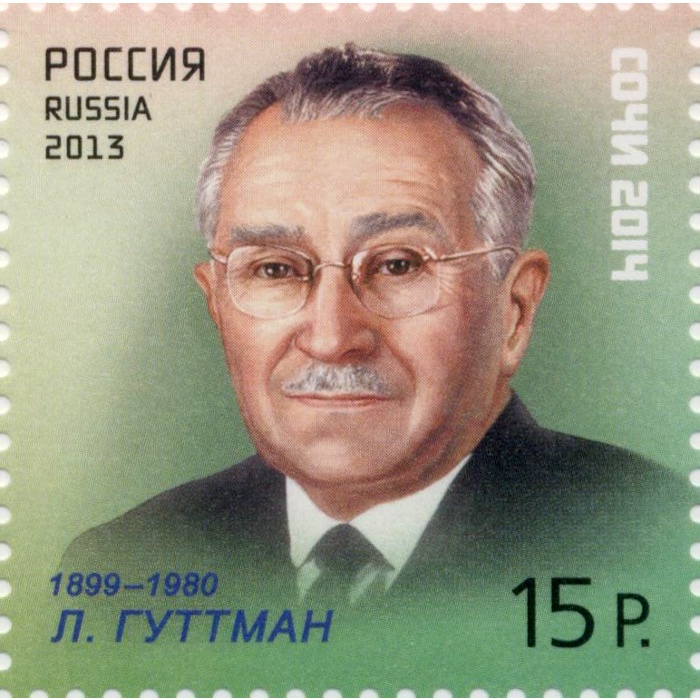|
Britta Siegers
Britta Siegers (born 4 July 1966) is a retired German wheelchair tennis player and Paralympic swimmer who competed in international level events. She was the first German disabled athlete to compete in two different sports at the Paralympics: she was a swimmer from 1984 to 1992 and returned twelve years later as a wheelchair tennis player at the 2004 Summer Paralympics. Swimming career Siegers' first sport was swimming when she started in 1969 after she lost both of her legs in a train accident aged two years old. She swam competitively in 1984 at the Summer Paralympics and won her first medals there. Her most successful Paralympic Games was in 1992 where she won five gold medals, two silvers and one bronze medal, she narrowly missed winning her consecutive freestyle titles after being beaten by Priya Cooper in both the 50m and 100m freestyle S8. Tennis career Siegers began playing wheelchair tennis in the early 1994 after her retirement to swimming in 1992. She won seven sing ... [...More Info...] [...Related Items...] OR: [Wikipedia] [Google] [Baidu] |
Paralympic Swimming
Para swimming is an adaptation of the sport of swimming for athletes with disabilities. Para swimmers compete at the Summer Paralympic Games and at other sports competitions throughout the world. The sport is governed by the International Paralympic Committee. Both men and women compete in para swimming, racing against competitors of their own gender. Swimming has been a part of the Paralympic program since the 1960 Summer Olympics in Rome, Italy. Rules Rules for the sport are adapted from those set forth by the International Swimming Federation (FINA). Swimmers compete individually in backstroke, breaststroke, butterfly, freestyle, individual medley, and as teams in relay races. At the Paralympics, World Championships and other elite level competitions, swimmers compete in an Olympic-size swimming pool. Significant differences between able-bodied and para swimming include the starting position and adaptations allowed for visually impaired swimmers. Competitors may start ... [...More Info...] [...Related Items...] OR: [Wikipedia] [Google] [Baidu] |
Priya Cooper
Priya Naree Cooper, (born 2 October 1974) is an Australian world champion disabled swimmer, winning nine Paralympic gold medals as well as world records and world championships. She competed in the Australian swimming team at the 1992, 1996 and 2000 Summer Paralympics with an S8 classification. She was twice the co-captain of the Australian Paralympic team, including at the 2000 Paralympic Games in Sydney, and carried the Australian flag at the closing ceremonies for the 1992 and 1996 Summer Paralympics. Cooper has cerebral palsy and spends much of her time in a wheelchair. She attended university, working on a course in health management. After she ended her competitive Paralympic career, she became a commentator, and covered the swimming events at the 2002 Commonwealth Games. Early life Priya Naree Cooper was born on 2 October 1974''W.A. Hall of Champions'' inductee booklet. (2006) Published by the Western Australian Institute of Sport. p. 24. in Perth, Western Australia. Sh ... [...More Info...] [...Related Items...] OR: [Wikipedia] [Google] [Baidu] |
Medalists At The 1988 Summer Paralympics
A medal or medallion is a small portable artistic object, a thin disc, normally of metal, carrying a design, usually on both sides. They typically have a commemorative purpose of some kind, and many are presented as awards. They may be intended to be worn, suspended from clothing or jewellery in some way, although this has not always been the case. They may be struck like a coin by dies or die-cast in a mould. A medal may be awarded to a person or organisation as a form of recognition for sporting, military, scientific, cultural, academic, or various other achievements. Military awards and decorations are more precise terms for certain types of state decoration. Medals may also be created for sale to commemorate particular individuals or events, or as works of artistic expression in their own right. In the past, medals commissioned for an individual, typically with their portrait, were often used as a form of diplomatic or personal gift, with no sense of being an award for ... [...More Info...] [...Related Items...] OR: [Wikipedia] [Google] [Baidu] |
Medalists At The 1984 Summer Paralympics
A medal or medallion is a small portable artistic object, a thin disc, normally of metal, carrying a design, usually on both sides. They typically have a commemorative purpose of some kind, and many are presented as awards. They may be intended to be worn, suspended from clothing or jewellery in some way, although this has not always been the case. They may be struck like a coin by dies or die-cast in a mould. A medal may be awarded to a person or organisation as a form of recognition for sporting, military, scientific, cultural, academic, or various other achievements. Military awards and decorations are more precise terms for certain types of state decoration. Medals may also be created for sale to commemorate particular individuals or events, or as works of artistic expression in their own right. In the past, medals commissioned for an individual, typically with their portrait, were often used as a form of diplomatic or personal gift, with no sense of being an award for ... [...More Info...] [...Related Items...] OR: [Wikipedia] [Google] [Baidu] |
Wheelchair Tennis Players At The 2004 Summer Paralympics
A wheelchair is a chair with wheels, used when walking is difficult or impossible due to illness, injury, problems related to old age, or disability. These can include spinal cord injuries (paraplegia, hemiplegia, and quadriplegia), cerebral palsy, brain injury, osteogenesis imperfecta, motor neurone disease, multiple sclerosis, muscular dystrophy, spina bifida, and more. Wheelchairs come in a wide variety of formats to meet the specific needs of their users. They may include specialized seating adaptions, individualized controls, and may be specific to particular activities, as seen with sports wheelchairs and beach wheelchairs. The most widely recognized distinction is between motorized wheelchairs, where propulsion is provided by batteries and electric motors, and manual wheelchairs, where the propulsive force is provided either by the wheelchair user or occupant pushing the wheelchair by hand ("self-propelled"), by an attendant pushing from the rear using the handle(s), or by ... [...More Info...] [...Related Items...] OR: [Wikipedia] [Google] [Baidu] |
Swimmers At The 1992 Summer Paralympics
Swimming is the self-propulsion of a person through water, or other liquid, usually for recreation, sport, exercise, or survival. Locomotion is achieved through coordinated movement of the limbs and the body to achieve hydrodynamic thrust that results in directional motion. Humans can hold their breath underwater and undertake rudimentary locomotive swimming within weeks of birth, as a survival response. Swimming is consistently among the top public recreational activities, and in some countries, swimming lessons are a compulsory part of the educational curriculum. As a formalized sport, swimming is featured in a range of local, national, and international competitions, including every modern Summer Olympics. Swimming involves repeated motions known as strokes in order to propel the body forward. While the front crawl, also known as freestyle, is widely regarded as the fastest out of four primary strokes, other strokes are practiced for special purposes, such as for training. ... [...More Info...] [...Related Items...] OR: [Wikipedia] [Google] [Baidu] |
Swimmers At The 1988 Summer Paralympics
Swimming is the self-propulsion of a person through water, or other liquid, usually for recreation, sport, exercise, or survival. Locomotion is achieved through coordinated movement of the limbs and the body to achieve hydrodynamic thrust that results in directional motion. Humans can hold their breath underwater and undertake rudimentary locomotive swimming within weeks of birth, as a survival response. Swimming is consistently among the top public recreational activities, and in some countries, swimming lessons are a compulsory part of the educational curriculum. As a formalized sport, swimming is featured in a range of local, national, and international competitions, including every modern Summer Olympics. Swimming involves repeated motions known as strokes in order to propel the body forward. While the front crawl, also known as freestyle, is widely regarded as the fastest out of four primary strokes, other strokes are practiced for special purposes, such as for training. ... [...More Info...] [...Related Items...] OR: [Wikipedia] [Google] [Baidu] |
Swimmers At The 1984 Summer Paralympics
Swimming is the self-propulsion of a person through water, or other liquid, usually for recreation, sport, exercise, or survival. Locomotion is achieved through coordinated movement of the limbs and the body to achieve hydrodynamic thrust that results in directional motion. Humans can hold their breath underwater and undertake rudimentary locomotive swimming within weeks of birth, as a survival response. Swimming is consistently among the top public recreational activities, and in some countries, swimming lessons are a compulsory part of the educational curriculum. As a formalized sport, swimming is featured in a range of local, national, and international competitions, including every modern Summer Olympics. Swimming involves repeated motions known as strokes in order to propel the body forward. While the front crawl, also known as freestyle, is widely regarded as the fastest out of four primary strokes, other strokes are practiced for special purposes, such as for training. ... [...More Info...] [...Related Items...] OR: [Wikipedia] [Google] [Baidu] |
Paralympic Wheelchair Tennis Players For Germany
The Paralympic Games or Paralympics, also known as the ''Games of the Paralympiad'', is a periodic series of international multisport events involving athletes with a range of physical disabilities, including impaired muscle power and impaired passive range of movement, limb deficiency, leg length difference, short stature, hypertonia, ataxia, athetosis, vision impairment and intellectual impairment. There are Winter and Summer Paralympic Games, which since the 1988 Summer Olympics in Seoul, South Korea, are held almost immediately following the respective Olympic Games. All Paralympic Games are governed by the International Paralympic Committee (IPC). The Paralympics has grown from a small gathering of British World War II veterans in 1948 to become one of the largest international sporting events by the early 21st century. The Paralympics has grown from 400 athletes with a disability from 23 countries in Rome 1960, where they were proposed by doctor Antonio Maglio, to 4 ... [...More Info...] [...Related Items...] OR: [Wikipedia] [Google] [Baidu] |
Paralympic Swimmers For Germany
The Paralympic Games or Paralympics, also known as the ''Games of the Paralympiad'', is a periodic series of international multisport events involving athletes with a range of physical disabilities, including impaired muscle power and impaired passive range of movement, limb deficiency, leg length difference, short stature, hypertonia, ataxia, athetosis, vision impairment and intellectual impairment. There are Winter and Summer Paralympic Games, which since the 1988 Summer Olympics in Seoul, South Korea, are held almost immediately following the respective Olympic Games. All Paralympic Games are governed by the International Paralympic Committee (IPC). The Paralympics has grown from a small gathering of British World War II veterans in 1948 to become one of the largest international sporting events by the early 21st century. The Paralympics has grown from 400 athletes with a disability from 23 countries in Rome 1960, where they were proposed by doctor Antonio Maglio, to 4,520 ... [...More Info...] [...Related Items...] OR: [Wikipedia] [Google] [Baidu] |
Sportspeople From Leverkusen
An athlete (also sportsman or sportswoman) is a person who competes in one or more sports that involve physical strength, speed, or endurance. Athletes may be professionals or amateurs. Most professional athletes have particularly well-developed physiques obtained by extensive physical training and strict exercise accompanied by a strict dietary regimen. Definitions The word "athlete" is a romanization of the el, άθλητὴς, ''athlētēs'', one who participates in a contest; from ἄθλος, ''áthlos'' or ἄθλον, ''áthlon'', a contest or feat. The primary definition of "sportsman" according to Webster's ''Third Unabridged Dictionary'' (1960) is, "a person who is active in sports: as (a): one who engages in the sports of the field and especially in hunting or fishing." Physiology Athletes involved in isotonic exercises have an increased mean left ventricular end-diastolic volume and are less likely to be depressed. Due to their strenuous physical activities, ... [...More Info...] [...Related Items...] OR: [Wikipedia] [Google] [Baidu] |
Living People
Related categories * :Year of birth missing (living people) / :Year of birth unknown * :Date of birth missing (living people) / :Date of birth unknown * :Place of birth missing (living people) / :Place of birth unknown * :Year of death missing / :Year of death unknown * :Date of death missing / :Date of death unknown * :Place of death missing / :Place of death unknown * :Missing middle or first names See also * :Dead people * :Template:L, which generates this category or death years, and birth year and sort keys. : {{DEFAULTSORT:Living people 21st-century people People by status ... [...More Info...] [...Related Items...] OR: [Wikipedia] [Google] [Baidu] |










